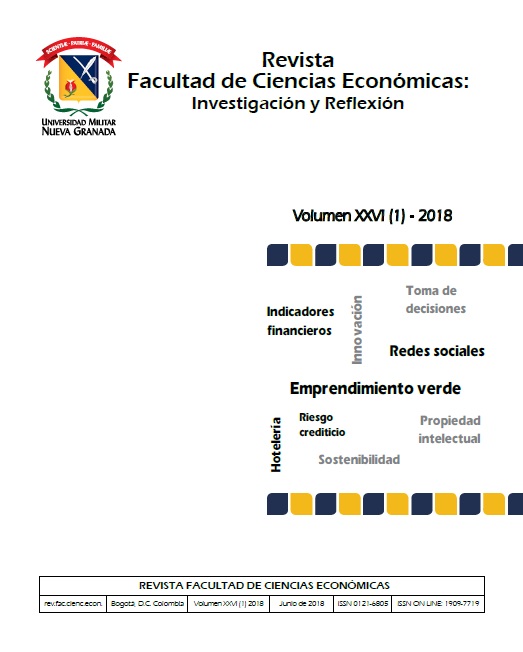Análise semiparamétrico dos fatores associados à sustentabilidade dos empreendimentos
Resumo
O presente artigo, produto de pesquisa, pretende identificar e analisar os fatores que determinam a sustentabilidade dos empreendimentos, evidenciando a relevância dos efeitos individuais e cruzados, relacionados com o empreendedor, o empreendimento e o meio, na subregião do Baixo Cauca – Colômbia, para o qual se abordou uma metodologia quantitativa mediante um modelo semiparamétrico. Utilizou-se uma mostra de 101 empreendedores, 73 ativos e 28 inativos. A principal contribuição desta pesquisa é determinar o grau em que a cada variável, das identificadas para o estudo – elaboração do plano de negócios, localização, endividamento, diversificação da oferta e forma jurídica –, individualmente e em interação com outras, afeta a sobrevivência dos empreendimentos.Downloads
Referências
Allison, P. (1984) Event history analysis. Londres: Sage Publications. https://doi.org/10.4135/9781412984195
Aranguren, M. J., Larrea, M. & Pe-a, I. (1999). Incubadoras: ¿Supervivencia y Crecimiento de Nuevas Empresas?. Encuentro de Economía Aplicada, Reus. 1-27.
Arias, A., Jung, A. & Pe-a, I. (2007). Factores asociados al cese de actividades de nuevas firmas espa-olas. Cuaderno de Economía, Uruguay, Departamento de Economía, Facultad de Ciencias Empresariales, Universidad Católica del Uruguay II (2), 7-21
Arias, A. & Quiroga, R. F. (2008). Cese de actividades de las pymes en el área metropolitana de Cali (2000-2004): un análisis de supervivencia empresarial. Cuaderno Administración Bogotá, XXI (35), 249-277.
Baumol, W. J. (1996). Entrepreneurship : Productive, Unproductive and Destructive. Journal of Business Venturing, 11 (1): 3-22. https://doi.org/10.1016/0883-9026(94)00014-X
Bird, B. (1989). Entrepreneurial Behavior. Scott, Foresman and Company. En: Glenview (IL). BIS.
Boden, R. J. & Nucci, A. R. (2000) On the survival prospects of men's and women's new business ventures. Journal of Business Venturing, XV (4), 347–362. Disponible: http://doi.org/10.1016/S0883-9026(98)00004-4.
Bracke, P., Hilber, C. & Silva, O. (2015). Mortgage debt and entrepreneurship (Bank of England working papers). En: Bank of England. Retrieved from, https://ideas.repec.org/p/boe/boeewp/0560.html.
Cámara de Comercio de Medellín para Antioquia. (2013). Permanencia Empresarial en Antioquia en el período 2000-2012. Revista Antioque-a de Economía y Desarrollo RAED, ed. (6): 45-85
Campbell, C. A. (1992). A decision theory model for entrepreneurial acts. Entrepreneurship: Theory and Practice. p. 21-28.
Canedo, J., Stone, D., Black, S. & Lukaszewski, K. (2014). Individual factors affecting entrepreneurship in Hispanics. Journal of Managerial Psychology, 29 (6): 755-772. https://doi.org/10.1108/JMP-11-2012-0333
Casson, M. (1983). The Entrepreneur- An Economic Theory. Albro Business History Review. 570-572
Cooper, A. C., Woo, C. Y. & Dunkelberg, W. C. (1989) Entrepreneurship and the initial size of firms. Journal of Business Venturing, IV (5): 317–332, Disponible: http://doi.org/http://dx.doi.org/10.1016/0883-9026(89)90004-9.
Cox, D. R. (1972). Regression Models and Life-Tables. Journal of the Royal Statistical Society. Series B (Methodological), XXXIV (2), 187–220. Disponible: http://doi.org/10.2307/2985181.
Cuervo, Á., Ribeiro, D. & Roig, S. (2007). Entrepreneurship: Conceptos, Teoría y Perspectiva. Revista de la Universidad de Valencia. https://doi.org/10.1007/978-3-540-48543-8
Fertala, N. (2008). The shadow of death: do regional differences matter for firm survival across native and immigrant entrepreneurs?. Empirica, XXXV (1), 59-80. https://doi.org/10.1007/s10663-007-9051-2
Flores-Luna, C, M., Mu-oz, S. Z., Salazar-Martínez, E. & Lazcano-Ponce, E. (2000). Análisis de supervivencia. Aplicación en una muestra de mujeres con cáncer cervical en México. Salud pública de México, 42 (3), 242–251. https://doi.org/10.1590/S0036-36342000000300011
Gartner, W. B. (1988). "Who is an Entrepreneur?" Is the Wrong Question. Educational Foundation, 11-32.
Groszkowski, T. & Stryjewski, T. (2015). The Econometric Analysis of Entrepreneurship Determinants in Polish Voivodeships in the Years 2004–2013. Dynamic Econometric Models. 15, 157-165. https://doi.org/10.12775/DEM.2015.008
Ha, N. (2012). The effect of growth on firm survival in vietnam. Depocen Working Paper Series, 18.
Iturriaga, M., Baniandrés, J. & Eizaguirre, A. (2016) Del emprendimiento individual a la capacidad emprendedora de nuestras organizaciones: un análisis de los factores que la definen. Boletin de estudios económicos. LXXI (217): 49-69
Jung, A. & Pe-a, I. (2004). Factores asociados al fracaso de nuevas empresas. En: III Conferencia Internacional de Investigadores en Emprendedurismo de América Latina, Rio de Janeiro, 56-68.
Kaplan, E, & Meier, P. (1958). Nonparametric estimation from incomplete observations. Journal of the American Statistical Association, LIII (282), 457-481. https://doi.org/10.1080/01621459.1958.10501452
Katz, J. A. (1992). A Psychosocial Cognitive Model of Employment Status Choice. Entrepreneurship: Theory y Practice, 29-37.
Lau, T. & Chan, K. F. (1994). The Incident Method - An Alternative Way of Studying Entrepreneurial Behaviour. Irish Business and Administrative Research. 15: 48
Martínez, A. F. (2006). Determinantes de la supervivencia de empresas industriales en el área metropolitana de Cali 1994-2003. Revista Sociedad y Economía. (11), 112-144.
Marulanda, J. A., Correa, G. & Mejía, L. F. (2009). Emprendimiento: Visiones desde las teorías del comportamiento humano. Revista EAN, (66): 153-168.
Mas-Verdú, F., Ribeiro-Soriano, D. & Roig-Tierno, N. (2015). Firm survival: The role of incubators and business characteristics. Journal of Business Research, 68(4), 793–796. http://doi.org/DOI: 10.1016/j.jbusres.2014.11.
Moriano, J. A., Trejo, E. & Palací, F. J. (2001). El Perfil Psicosocial del Emprendedor: Un estudio desde la perspectiva de los valores. Revista de Psicología Social, (16): 229-242. https://doi.org/10.1174/021347401317351152
Noguera, M., Alvarez, C., Merigó, J. & Urbano, D. (2015). Determinants of female entrepreneurship in Spain: an institutional approach. Computational and Mathematical Organization Theory. 21 (4): 341-355. https://doi.org/10.1007/s10588-015-9186-9
Parra, J. F. (2011). Determinantes de la probabilidad de cierre de nuevas empresas en Bogotá. Revista Facultad de Ciencias Económicas: Investigación y Reflexión, XIX (1), 27-53.
Pereira, F. & Medina, L. (2012). Global Entrepreneurship Monitor -GEM-Antioquia 2012-2013. Colombia: Ediciones Sello Javeriano.
Perinat, A. (1980). Contribuciones de la Etología al Estudio del Desarrollo Humano y Socialización. El Basilisco, (11): 27-34.
Phillips, B. & Kirchhoff, B. (1989). Formation, Growth and Survival; Small Firm Dynamics in the U.S. Economy. Small Business Economics, I (1), 65-74. https://doi.org/10.1007/BF00389917
Rajasekaran (2013). Sustainable Entrepreneurship: Past Researches and Future Directions. Journal of Entrepreneurship and Management, 2 (1): 20-27.
Reynolds, P. D., Carter, N. M., Gartner, W. B. & Greene, P. G. (2004). The Prevalence of Nascent Entrepreneurs in the United States: Evidence from the Panel Study of Entrepreneurial Dynamics. Small Business Economics, (23), 263-284. https://doi.org/10.1023/B:SBEJ.0000032046.59790.45
Rocha, V., Carneiro, A. & Amorim Varum, C. (2015). Serial entrepreneurship, learning by doing and self-selection. International Journal of Industrial Organization, 40: 91–106. http://doi.org/10.1016/j.ijindorg.2015.04.001
Rodriguez, A. (2009). Nuevas perspectivas para entender el emprendimiento empresarial. Pensamiento y Gestión, (26): 94-119.
Ronstadt, R. S. (1984). Entrepreneurship: Text, Cases and Mites. Lord Publishing, Dover (MA).
Schaltegger, S. & Wagner, M. (2011). Sustainable Entrepreneurship and Sustainability Innovation: Categories and Interactions. Business Strategy and the Environment Business, (20): 222-237.
Sepulveda, C. & Reina, W. (2015). Sostenibilidad de los emprendimientos: Un análisis de los factores determinantes. Revista Venezolana de Gerenecia (23), 33-49
Shane, S. & Venkataraman, S. (2000). The Promise Of Entrepreneurship As A Field Of Research. Academy of Management Review, (25), 217-227. https://doi.org/10.5465/AMR.2000.2791611
Simon, V. M., Revuelto L.T. & Medina, A. F. (2012). La influencia de la formación, la experiencia y la motivación para emprender en la supervivencia de las empresas de nueva creación. Estudios gerenciales, XXVIII, (Edición especial), 237-262.
Stuart, R. W. & Abetti, P. A. (1990). Impact of entrepreneurial and management experience on early performance. Journal of Business Venturing, V (3), 151–162, Disponible: http://doi.org/http://dx.doi.org/10.1016/0883-9026(90)90029-S.
Tavassoli, S. & Jienwatcharamongkhol, V. (2016). Survival of Entrepreneurial Firms : The Role of Agglomeration. Externalities Papers in Innovation Studies. CIRCLE, (October)
Taymaz, E; Köksal, M. (2006). El espíritu emprendedor, el tama-o de lanzamiento y la supervivencia de los peque-os empresarios. En: Ekonomiaz: Revista vasca de economia, (62): 70-99.
Tinbergen, N. (1963). On Aims and Methods of Ethology. Department of Zoology. Revista University of Oxford, 20: 410-433.
Turkina, E. & Thi, M. T. (2015). Socio-psychological determinants of opportunity entrepreneurship. International Entrepreneurship and Management Journal, 11 (1): 213-238 https://doi.org/10.1007/s11365-013-0288-x
Wompner, F. (2008). Educación superior para el emprendimiento. Expansiva. Serie indagación 19.
Yeasmin, N. (2016). The Determinants of Sustainable Entrepreneurship of Immigrants in Lapland: En Analysis of Theoretical Factors. Entrepreneurial Business and Economics Review, 4(1): 129-159.











